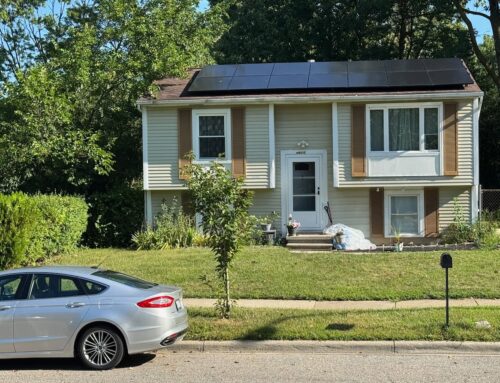Trump’s Energy Policies Cast Shadow Over U.S. Wind Industry
February 8, 2025
ByFelicity Bradstock– Feb 08, 2025, 4:00 PM CST
- President Trump’s administration has implemented policies that prioritize fossil fuel production and create uncertainty for renewable energy projects, including halting some funding and development.
- Despite the challenges, many wind energy companies and industry experts remain optimistic about the long-term prospects of the U.S. market, citing existing projects and rising energy demand.
- The shift in administration has caused some delays and financial strain for wind energy companies, but the overall transition to renewable energy is viewed by some as unstoppable.

President Trump has been emphatic about his support for oil and gas throughout his electoral campaign and since coming into office. In addition, he has made it clear that he is far less supportive of renewable energy, calling Biden’s groundbreaking climate policy – the Inflation Reduction Act (IRA) – a “Green New Scam. Greatest scam in history, probably.” While many U.S. energy leaders believe the green transition is unstoppable, Trump appears set on restricting renewable energy expansion in favour of growing the domestic fossil fuel industry.
During his first two weeks in office, President Trump signed a flurry of executive orders, several of which were directed at oil and gas. He issued orders to enhance access to more land and water across the U.S. for fossil fuel exploration and began the process of withdrawing the U.S. from the Paris climate agreement. Trump has repeatedly stated “We will drill, baby drill,” when asked about energy, referring to his intention to boost domestic oil and gas output.
‘;
document.write(write_html);
}
By contrast, he has already started to look for ways to upend the progress made by the U.S. in terms of renewable energy, by halting several projects and creating a general uncertainty in the sector. The Department of the Interior temporarily suspended all renewable energy development on federal land, while it granted permission for fossil fuel operations. Trump also declared an “energy emergency”, stating the need to boost “crude oil, natural gas, lease condensates, natural gas liquids, refined petroleum products, uranium, coal” output, with no mention of renewable energy sources. Trump has already introduced a pause on some IRA and Bipartisan Infrastructure Law (BIL) funding and a freeze on federal grants and loans.
In the past, Trump has spoken negatively about wind energy, calling it “disgusting” and blaming it for the death of various wildlife, without providing any evidence. In January, Trump told Fox News, “We don’t want windmills in this country. I’m going to put it. We’re putting an order on. I’ve already sort of done it.”
Trump has also spoken disparagingly of solar power. “You know what people also don’t like, those massive solar fields built over land that cover 10 miles by 10 miles,” Trump said. “I mean they are ridiculous, the whole thing.”
His attacks on solar and wind energy have left the energy industry uncertain about the investment environment for renewable energy and clean tech, unsure whether the Trump administration will follow the aims outlined in the IRA. Having spent billions on developing domestic clean energy capacity, several companies are now in wait-and-see mode when it comes to financing new projects or expanding existing operations.
This sectoral uncertainty comes at a time when several wind energy companies are already suffering. Denmark’s wind major Orsted saw its shares fall by as much as 18 percent after it announced it had $1.7 billion in impairments in January. In addition to Trump’s pause on U.S. offshore wind lease sales in federal waters, Orsted has been facing challenges including supply-chain bottlenecks and high financing costs.
At the end of January, Orsted announced that its CEO Mads Nipper was stepping down. Rasmus Errboe, formerly deputy chief executive and chief commercial officer, replaced Nipper. There have been severe delays in Orsted’s Sunrise Wind project off the coast of New York due to supply-chain constraints and construction issues, which have driven costs up. It was initially expected to come online next year but this date has now been shifted to the second half of 2027.
Despite the wide array of challenges, many wind and solar energy players remain optimistic about the U.S. market. Following the announcement of Trump’s executive orders, Spanish renewable energy firm Iberdrola said the transition away from fossil fuels was “absolutely unstoppable.” Ignacio Galán, the executive chairman of Iberdrola, stated, “We are seeing that probably we are in the best moment for electrification,” in reference to the rising energy demand from tech companies. Galán added, “We are very, very optimistic about the United States and the future.”
Research and energy intelligence company Rystad Energy was also optimistic about the U.S. wind energy market. Artem Abramov, the company’s head of new energies research, said that while the potential for new offshore wind developments is currently non-existent under Trump, existing projects will still go ahead.
Abramov explained, “The U.S. currently has around 2.4 gigawatts (GW) of advanced-stage offshore wind developments that have reached final investment decision and are under construction, which are unlikely to be impacted by the order.” He added, “Moderate risk amid the unfavourable investment climate is present for 10.5 GW of projects, which secured necessary permits but have not reached investment decisions.” Meanwhile, “The remaining 25 GW of early-stage projects are unlikely to see any progress under the current administration.”
Wind and solar energy companies are seeing a bump in the road after several years of expansion and a strong investment environment. The change in administration could shift the U.S. energy outlook, as Trump looks to boost domestic fossil fuel production and curb progress in green energy. However, many business executives and oil and gas majors now favour renewable energy, having invested billions in the diversification of their portfolios, supported by financial incentives and policies. This will likely encourage Trump to resume solar and wind energy leases and allow for the growth of alternative energies alongside oil and gas.
By Felicity Bradstock for Oilprice.com
More Top Reads From Oilprice.com
Search
RECENT PRESS RELEASES
Related Post




